The AT-6’s large, two-place greenhouse canopy required significant changes to match the single seat Zero canopy. The modifications required a new windshield and upper deck. They raised the canopy rails by a few inches and constructed a new, faired canopy to resemble a Zero’s. The conversion team enlarged the engine cowling, and repositioned the carburetor air scoop with the oil cooler scoop. They also added non-adjustable cowl flaps, cut slots into the fuselage sides, and changed the wing-to-fuselage fillets to help with the Harvard’s aerodynamic shape. They then reshaped the Texan’s wing tips in fiberglass to look more like a Zero’s, and added BT-13 tail wheel assemblies which could also retract. The team added landing gear doors to the undercarriage and mounted a fiberglass addition to the wing’s leading edge extending from the wing root to the wing attachment joint. This leading edge fairing hid the distinctive shape of the AT-6’s landing gear wheel wells. The rudder profile needed adjustments too, which they achieved with fiberglass add-ons at the upper and lower ends. The conversion team then put a rather large spinner over the AT-6’s normally bare propeller hub. They also added simulated machine ports to the cowling and wing-mounted cannon to complete the lethal look.
Creating the replica Kates required a little more work than the Zeros. A real Kate has a very long fuselage that houses a three-place cockpit area. The starting point was an AT-6 airframe, at least the front end. They removed the entire fuselage from just behind the cockpit, inserted a custom-built 6’11” fuselage extension and coupled that to the tail unit from a BT-13 with a reshaped, more Kate-like fin and rudder. Then they added a custom 16″ fuselage plug forward of the firewall, while extending and reshaping the wingtips using fiberglass. The modifications also included a completely new, five-section greenhouse canopy with a section for the addition of a third rearwards facing seat for the tail gunner. The “Kate” also acquired a replica, belly-mounted fiberglass torpedo. The final result was a practically perfect replica of a B5N Kate.
The replica Val required the most extensive modifications to achieve a movie version of the Aichi D3A Type 99 dive bomber. It needed a new engine, propeller, and extensive changes to the fuselage shape, cockpit, wing and tail, but the final result is impressive, and bears a strong resemblance to an original Val. In all, Stewart-Davis and Cal-Volair built twenty five replica Zeros, nine Kates and nine Vals between them. A few of each type had three-bladed props, gear-cased engines and tail hooks fitted for close-up scenes and carrier landings. In addition, Kawasaki Aircraft modified nineteen further AT-6s in Japan using the “California pattern” for second unit filming in that country. Tragically, Jack Canary was not there to see his “Fox Air Force” become a reality. He died in August 1968 while flying one of the Valiants to California for conversion. Interestingly, the production company filmed footage of the Japanese replicas taking off for the raid using the USS Yorktown (CVS-10) as a substitute for one of the six Japanese aircraft carriers in the attack, herself a veteran WWII carrier. The film producers leased the ship, and paid Navy personnel to work on the production. Yorktown was scheduled for decommissioning a short while after the production, so the interruption in her regular activities didn’t pose a burden upon the fleet. The film crew made the carrier shots off San Diego.
At the conclusion of filming, some of the aircraft returned to their original configuration, but most remained as they were for the movie. Of these, the production company donated four Zeros, a Val and a Kate to the CAF in October 1971. These six aircraft made up the first group of aircraft for the TORA TORA TORA team. Nevertheless, this beginning was not particularly easy, as CAF policy pledged to operate only original, American aircraft, and not replicas. For this reason, the aircraft remained parked for several years and began to deteriorate. A change in fortune came when a CAF member had the idea to organize an air show display routine with the aircraft in remembrance of Pearl Harbor. The CAF needed to completely refurbish the aircraft and install radios. CAF Colonel Buddy Cooksey, one of the first formation members, recollects that the display team’s first appearance, quickly baptized “TORA TORA TORA”, occurred at Galveston airport on June 25th, 1972. On this occasion the formation displayed during the singing of the national anthem. The display routine quickly became a success, creating increased interest and, resulting in frequent participation at subsequent events. However, during the early years of the team, they limited themselves to shows in Texas and Louisiana. The team’s now-famous pyrotechnic displays also occurred in 1975, and from that moment on the team’s success continually increased. The number of aircraft and personnel involved gradually increased too. By the end of the 1970s, the team was performing all across North America, including Canada and Mexico.
Mark Allen recently stated that, “To be leader of TORA TORA TORA is both a great honor and an enormous responsibility. The team has been successfully displaying for almost forty years, and it is my specific responsibility to ensure the formation maintains the highest standards. We presently have fourteen pilots and more than forty people who work with the Bomb Squad, all volunteers, and drawn from the various areas of the United States, and whose background work represents the key to the success of the team. We have a total of twelve aircraft flying with us, although normally we perform our show with at least eight aircraft. In some cases we can also perform a reduced show, with four or six aircraft, and without the pyrotechnic display, which is strictly reserved for full-team displays. It should also be also noted that we can normally count on five further fighter aircraft, P-40 or P-51D, which, depending on their availability, are used to simulate a combat engagement between Japanese and American fighters. Furthermore, following the completion of its restoration, we also have B-17G “Texas Raiders” back flying in our show, simulating one of the formation of bombers which arrived from continental America, which tries to land with only one undercarriage leg lowered while being overflown by Japanese aircraft. The aircraft are the property of the CAF, which assigns the management of them to individual pilots, who can cover at their own expense, or through sponsorship, their maintenance and servicing. In practice, ours is a right and proper hobby, and the income derived from our participation in air displays is just sufficient to cover our running costs. Despite this, being part of TORA TORA TORA is a ambition for every pilot, although the turnover is fairly limited, also linked to the fact that we have to be highly selective when accepting new pilots, who have to be in possession of particular flying capabilities, especially on the T-6, and also exceptional personal characteristics. The fact has certainly had a positive influence on the safety of our display, which is essentially based on extreme precision and respect for the planned flying parameters, indispensable factors when around ten aircraft that are maneuvering in opposite directions in such restricted airspace. In this light, before the beginning of every season, we meet up to undergo specific formation training sessions, even managing to fly more than five times over the weekend.
CAF Colonel Buddy Cooksey adds that, “Hollywood has turned to us on other occasions for airborne filming, such as in 1977, when two TORA TORA TORA Zeros, AI-113 and AI-114, were used for filming the TV series BAA BAA BLACK SHEEP. In 1979, four TORA TORA TORA Zeros participated in filming aerial actions in THE FINAL COUNTDOWN, a famous movie in which [F-14] Tomcats of the then VF-84 Jolly Rogers embarked on the USS NIMITZ were engaged in an improbable aerial dual with three Zero in the skies of the Pacific, as the carrier and all its air group had been “catapulted” back through time to December 1941. Other no less famous films which used our particular “air force” have been PEARL HARBOR, that saw the participation of Kates AII-356, AI-310 and AI-313 and two Vals, BI-257 and EI-231, that were shipped to Hawaii for the filming. Unfortunately during filming the movie, VAL EI—231 was lost having hit a palm tree.”
Cooksey describes that during the regular air show routine, the usual sequence of events occurs as follows. Just before take-off, Mark Allen gives the group a brief rundown on the display details. Narrator, Ken Crites or Roger Gauert, starts the show with a brief overview of the CAF and then takes the crowd back to December 7th 1941 at Pearl Harbor. Suddenly the crowd hears the piercing shriek of an air-raid siren, while the formation begins the attack with a choreographed “fan break”. At this point some of the Zeros begin diving down on the airfield and to simulate strafing passes, while others fly higher orbits protecting the Val dive-bombers and Kate torpedo planes. The latter, one behind the other, perform low level passes along the runway, simulating torpedo drops, while the Vals perform steep descent and recoveries during their dive-bombing attacks. Closer to the public, a Zero engages in simulated combat with an American fighter, usually a P-40 Warhawk or a P-51D Mustang, while a carousel of the other aircraft continues, filling the airspace around a stretch of runway some 900 meters long and 300 meters wide.
During their display, the team makes wide use of artificial explosions to signify bomb hits and to increase the spectacle for the public. In charge of all the pyrotechnic activities is Gordon Webb, who took on this role by chance a few years ago after being recommended by a friend. He leads a “bomb squad” of some fifty pyrotechnic staff. Created “officially” in 1987, the Bomb Squad provides pyrotechnic support for the Team. At present, the pyrotechnic show requires at least ten people for every display, and many of these are volunteers coming from various parts of the United States. During the eighteen minute flying show, more than sixty explosions simulate the bombs to enable the public to realistically relive those tragic minutes at the beginning of war in the Pacific. Allen stated that, “We are very proud of the high standard of safety we have achieved, thanks mainly to the fact that we never use explosives of the type used in fireworks, which we consider too dangerous and difficult to manage. In reality, we use commercially available explosives which, when formed into small detonators cause small sacks to explode, these containing essentially petrol. As these detonate they create a sudden and impressive burst of flame which is followed by intense black smoke.”
At a distance of nearly forty years from their first air display, TORA TORA TORA is today a real event, the pride of every airshow which presents it, thanks to both its popularity and the successes achieved through professionalism, safety, and spectacle.
The author thanks all the guys of TORA TORA TORA and particulary Mark Allen, Bud Cooksey, Jim, Mike Burke and Myriam Ryan for the friendly support and Frank McMeicken for the translation.

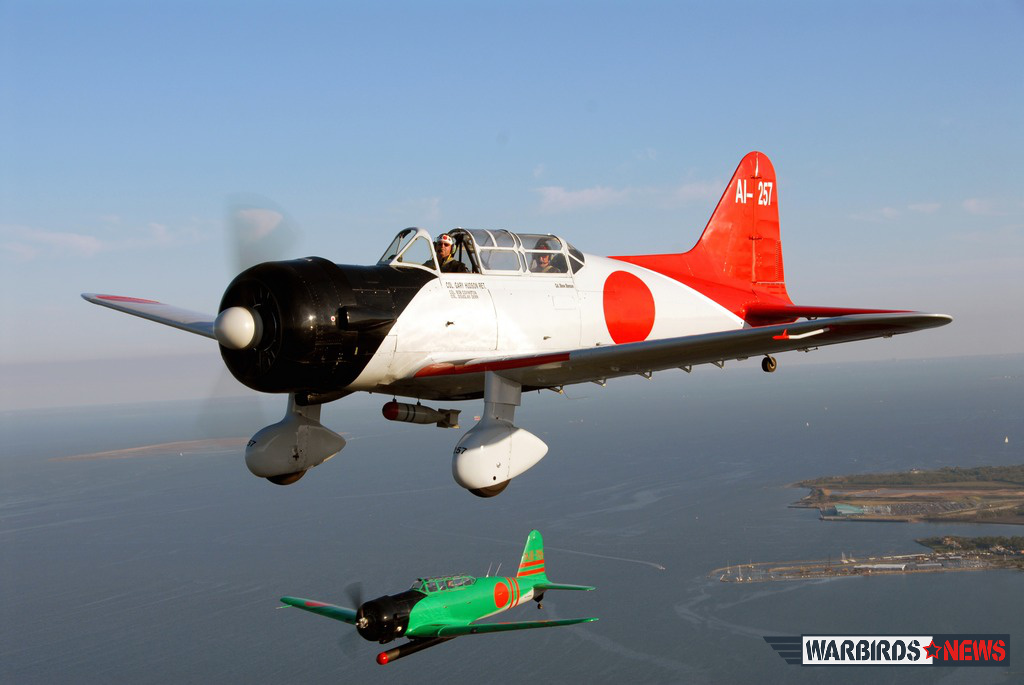
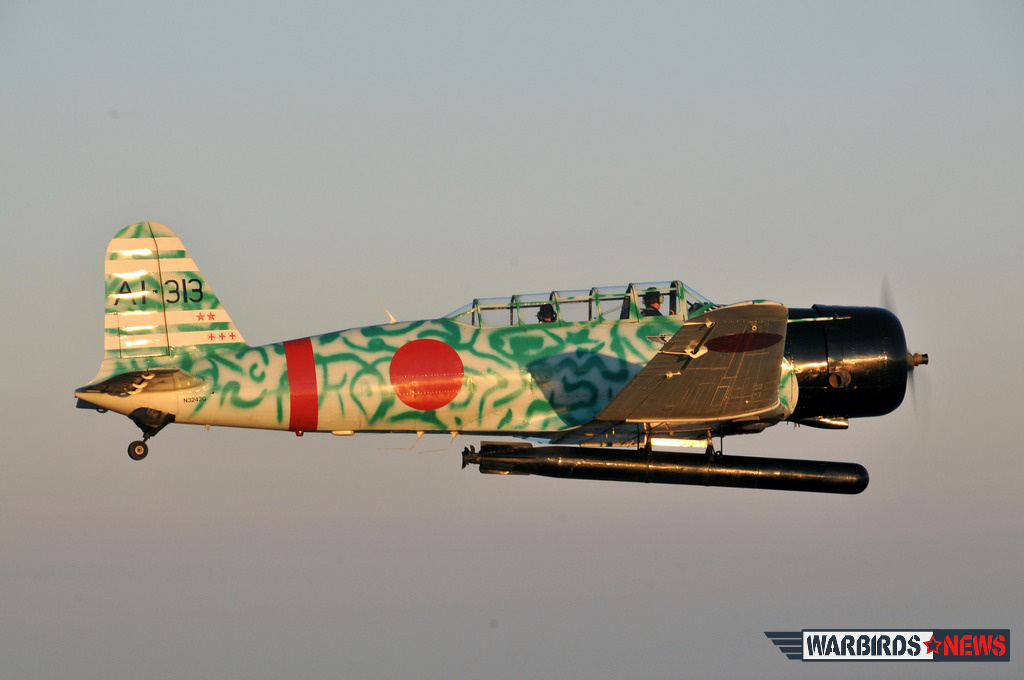
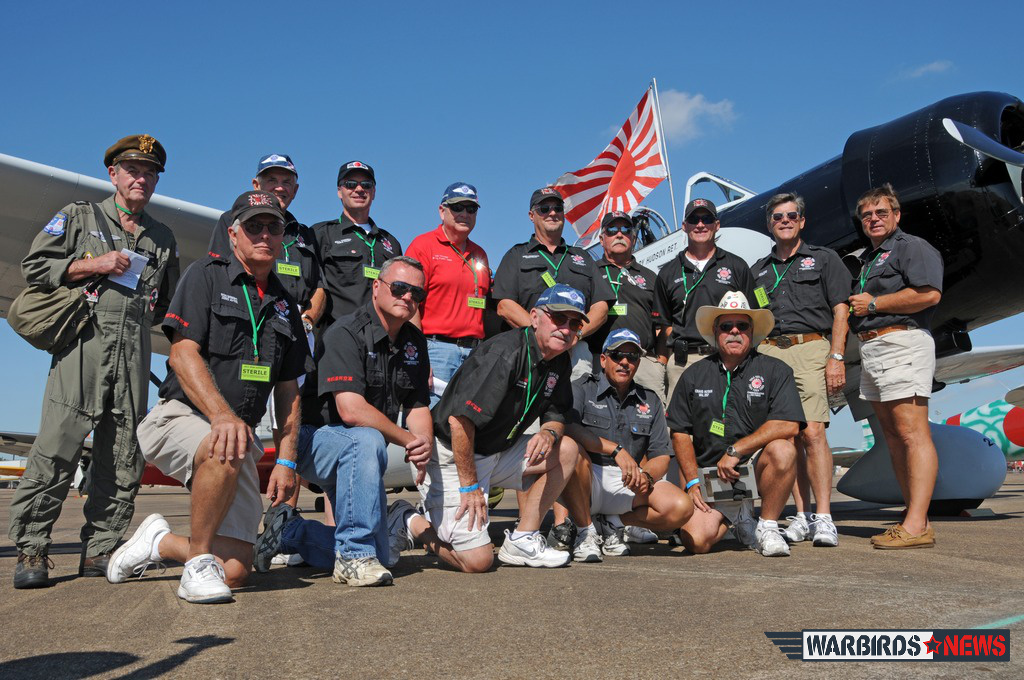
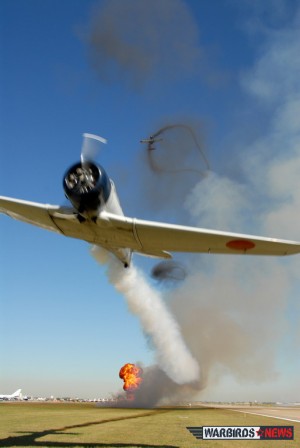
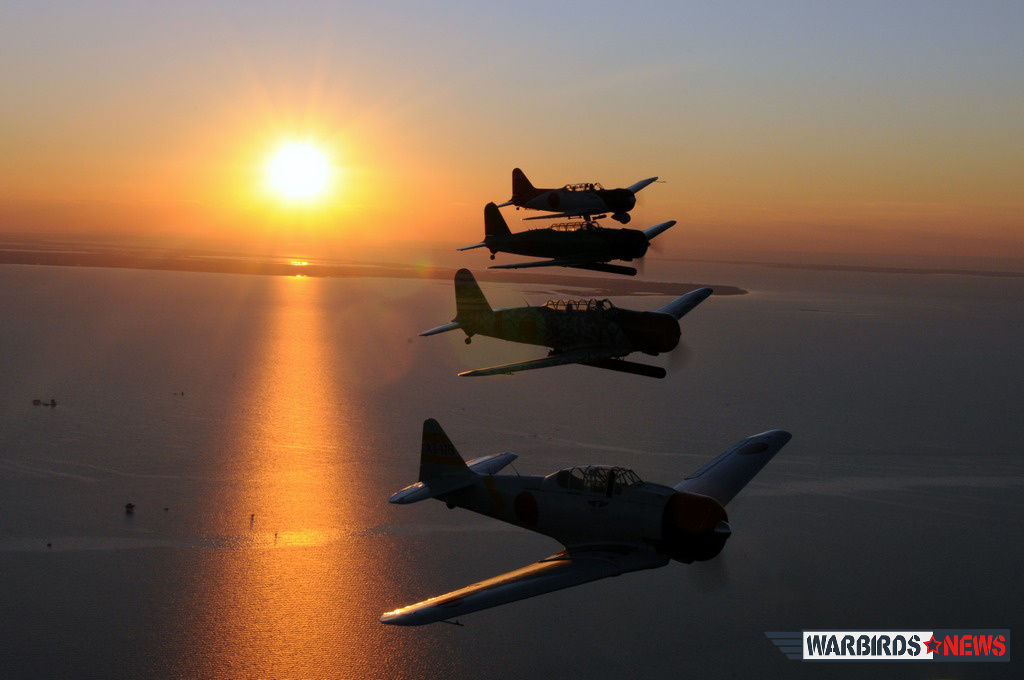

– I like very much, this kind, of flying !
– Hugs !